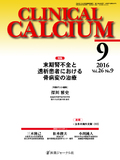Japanese
English
- 有料閲覧
- Abstract 文献概要
- 1ページ目 Look Inside
- 参考文献 Reference
慢性腎臓病(CKD)では,以前から血中リン(Pi)蓄積に伴う二次性副甲状腺機能亢進症に伴ってCKD-骨ミネラル代謝異常(MBD)が発症し,血管合併症や骨折の危険性が増す。CKD早期のステージ2から,血液中へのPi負荷増大や,酸化ストレスの増大,栄養障害,さらにはサルコペニアに伴う転倒リスク増大が,CKDの易骨折に関与すると考えられている。最近ではCKD患者での骨粗鬆症診療が,カルシウム(Ca)過剰症やそれに伴う骨代謝回転抑制が無形成骨を惹起することで,血管石灰化をはじめとする動脈硬化進行に関与することが示されている。高齢女性の骨粗鬆症患者の多くがCKDに罹患していることから,CKD患者での骨粗鬆症治療における薬剤選択において,Ca・Pi負荷過剰や代謝回転過剰抑制を避けるという視点からの戦略立案が,ますます重要となる。
Chronic kidney disease causes secondary hyperparathyroidism due to an accumulation of phosphate in the circulation, resulting in the development of CKD-mineral bone disease(MBD), which increases the risk of cardiovascular disease and fracture. Increase of bone fracture in CKD might be explained by phosphate overload, increased oxidative stress, malnutrition, and the increased risk of fall due to sarcopenia. It is recently emphasized that the overtreatment of osteoporosis might induce the development of adynamic bone disease by calcium overload and/or oversuppression of bone turnover, which might stimulate ectopic calcification including vessel wall. Considering for the high prevalence of CKD in elderly osteoporotic women, we should be careful to avoid the induction of calcium/phosphate overload and over-suppression of bone turnover when we treat osteoporosis for such patients.



